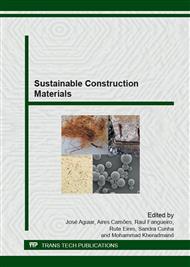[1]
T.P. Pinto, Metodologia para a gestão diferenciada de resíduos sólidos da construção urbana. 1999. 189f. Tese (Doutorado em Engenharia) - Escola Politécnica, Universidade de São Paulo, São Paulo, (1999).
DOI: 10.11606/9786589190202
Google Scholar
[2]
CONSELHO NACIONAL DO MEIO AMBIENTE. Brasília 2002. Resolução CONAMA n° 307, 2002. http: /www. mma. gov. br/port/conama/res/res02/res30702. html.
Google Scholar
[3]
P. E. M. Silveira, A aplicação de resíduos de construção e demolição reciclado no compósito solo-cimento. 2005. 138 f. Dissertação (Mestrado em Geociências) – Instituto de Geociências e Ciências exatas, Universidade Estadual Paulista, Rio Claro. (2005).
DOI: 10.3934/dcds.2013.33.803
Google Scholar
[4]
L. B. Bernucci et al., Pavimentação asfáltica: formação básica para engenheiros. 1. ed – Rio de Janeiro: PETROBRAS: ADEBA, (2006).
Google Scholar
[5]
ASSOCIAÇÃO BRASILEIRA DE NORMAS TÉCNICAS Solo-cimento – Ensaio de Compactação. NBR 12023. Rio de Janeiro, ABNT, (1990).
Google Scholar
[6]
DEPARTAMENTO DE ESTRADAS DE RODAGEM DO ESTADO DO PARANÁ. Pavimentação: solo-cimento e solo tratado com cimento, DER/PR ES-P 11/05, Curitiba, (2005).
Google Scholar
[7]
N. H. M. Gutierrez et al., Influência da microestrutura no comportamento de um solo tropical argiloso compactado com diferentes energias. In: COBRAMSEG 2010, 2010, Gramado. Engenharia Geotécnica para o Desenvolvimento: Inovação e Sustentabilidade, 2010. pp.1-8.
DOI: 10.4322/cobramseg.2022.0056
Google Scholar
[8]
S. E. Zordan, A utilizacao do entulho como agregado na confecção do concreto. 1997. 156 f. Dissertação (Mestrado em Engenharia Civil, na Area de Saneamento) – Universidade Estadual de Campinas, Campinas, SP. (1997).
DOI: 10.47749/t/unicamp.1997.115276
Google Scholar
[9]
R. S. Motta, Estudo laboratorial de agregados reciclados de resíduos sólidos da construção civil para aplicação em pavimentação de baixo volume de trafego. 2005. 161 f. Dissertação (Mestrado em Engenharia de Transportes) - Escola Politécnica da Universidade de São Paulo, São Paulo. (2005).
DOI: 10.11606/d.3.2005.tde-19072006-114729
Google Scholar
[10]
ASSOCIAÇÃO BRASILEIRA DE NORMAS TÉCNICAS - ABNT. Rochas e solos: terminologia, NBR 6502/95. Rio de Janeiro, 1995. 18p.
Google Scholar
[11]
DEPARTAMENTO NACIONAL DE INFRA-ESTRUTURA DE TRANSPORTES. Manual de pavimentação. 3. ed. Rio de Janeiro: Instituto de Pesquisas Rodoviárias, DNIT. 2006. 274p.
Google Scholar
[12]
ASSOCIAÇÃO BRASILEIRA DE NORMAS TÉCNICAS. Grãos que passam na peneira de 4, 8 mm – Determinação da massa específica. NBR 6508. Rio de Janeiro, ABNT. (1984).
Google Scholar
[13]
ASSOCIAÇÃO BRASILEIRA DE NORMAS TÉCNICAS. Solo – Determinação do limite de liquidez. NBR 6459. Rio de Janeiro, ABNT. (1984).
Google Scholar
[14]
ASSOCIAÇÃO BRASILEIRA DE NORMAS TÉCNICAS. Solo – Determinação do limite de plasticidade. NBR 7180. Rio de Janeiro, ABNT. (1984).
Google Scholar
[15]
ASSOCIAÇÃO BRASILEIRA DE NORMAS TÉCNICAS. Solo – Analise Granulométrica. NBR 7181. Rio de Janeiro, ABNT. (1984).
Google Scholar
[16]
ASSOCIAÇÃO BRASILEIRA DE NORMAS TÉCNICAS. Amostra de solo – Preparação para ensaios de compactação e ensaios de caracterização. NBR 6457. Rio de Janeiro, ABNT. (1986).
DOI: 10.11606/d.3.2012.tde-13062013-122430
Google Scholar
[17]
ASSOCIAÇÃO BRASILEIRA DE NORMAS TÉCNICAS. Solo-cimento – Moldagem e cura de corpos de prova cilíndricos. MB - 3360, ABNT. (1990).
Google Scholar
[18]
ASSOCIAÇÃO BRASILEIRA DE NORMAS TÉCNICAS. Solo-cimento – Ensaio de compressão simples de corpos de prova cilíndricos. NBR 12025. Rio de Janeiro, ABNT. (1990).
DOI: 10.1590/1807-1929/agriambi.v3n1p93-98
Google Scholar
[19]
A. Belincanta et al., Estudo experimental de solos do Noroeste do Paraná aditivados com cimento Portland. In: XIII Congresso Brasileiro de Mecânica dos Solos e Engenharia Geotécnica, 2006, Curitiba. Anais do III Congresso Luso-Brasileiro de Geotecnia, 2006. pp.83-88.
DOI: 10.20906/cps/cobramseg2016
Google Scholar
[20]
B. Muhunthan, F. Sariosseiri, Interpretation of geotechnical properties of cement treated soils. Research Report, Washington State Transportation Center (TRAC), Washington State University, Department of Civil & Environmental Engineering, Pullman, WA 99164-2910, (2008).
DOI: 10.30919/es.1803302
Google Scholar


